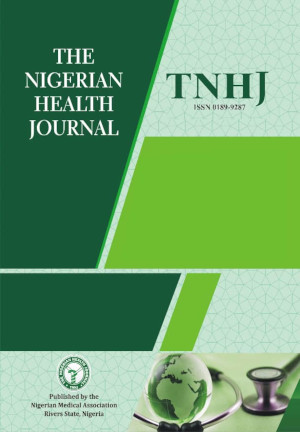Holoprosencephaly In A Nigerian Female: A Case Report
DOI:
https://doi.org/10.60787/tnhj.v9i1%20-%204.26Keywords:
holoprosencephaly, Radiologic diagnosis, NigeriaAbstract
Background: Holoprosencephaly is a complex intracranial abnormality with 3 ranges of severity: Lobar, semi-lobar and alobar. The clinical presentation with typical facial anomalies is unique. Imaging with USS, CT and MRI are useful diagnostic tools. We here report the first case of holoprosencephaly in the University of Port Harcourt Teaching Hospital and highlight the clinical and radiological diagnosis of this condition.
Methodology: The medical records of the patient who presented with Holoprosencephaly (HPE) and literature review of the subject using available journals and medline search were utilised. The reviewed radiologic investigation modality establishing the diagnosis was contrast enhanced computed Tomography in which axial noncontrast/postcontrast 10mm sections were taken and the axial images and reconstructions( coronal/ sagittal ) were reviewed. The Computed Tomography machine used is a Helical 8 slices General Electric Machine and contrast medium administered was Iopamidol in standard dose for weight
Result: A 1 day old female infant delivered in a peripheral hospital with absent nasal opening and neonatal asphyxia. Cranial computed tomography showed rudimentary nasal septum, hypotelorism and nasal apeture stenosis with absent interhemispheric fissure and falx cerebri, solitary widened monovertricle and fused thalami.
Conclusion: Holoprosencephaly is a rare congenital structural anomaly of the prosencephalon that results in incomplete development of the brain. In its severe form it is incompatible with life. Its etiology is not fully established
Downloads
References
Warkany J, Passarge E, Smith LB. Congenital Malformations in autosomal trisomy syndromes. Am J Dis Child 112:502-517,1966.
Van der Knaap MS, Valk J. Classisfication ofcongenital abnormalities of the CNS.AJNR 9:315-326, 1988.
Macahan PJ, Nyberg AD, Mac AC. Sonography offacial features of alobar and semi-lobar holoprosencephaly American Journal of Radiology (AJR) 1990; 154;143-148.
Susan DJ. Pediatric imaging. In Fundamentals ofrdDiagnostic Radiology: 3 Ed. New York; Lippincott Williams & Wilkins 2007:225-226.
De Meyer W. Holoprosencephaly. In Myrianthopoulos N (ed) : Malformations. New York ;Elsevier;1987: 225-244.
De Meyer W, Zeman W. Alobar Holoprosencephaly ( Arhinencephaly) with median cleft and palate: Clinical electroencephalo graphic and nosologic considerations. Confin Neurol 1963;23: 1-36.
Bendavid C, Dupe V. Holoprosencephaly: An update on cytogenetic abnormalities. American Journal ofMedical Genetics 2010 ;( 154C):86-92.
Demeyer W, Zeman W, Palmer CG. The face predicts the brain: Diagnostic significance of median facial anomalies for holoprosenscephaly (arhinencephaly). Paediatrics 1964; 34: 256-63.
Barness EG. Prosencephaly Growth Failure. In A Review of Potter's Pathology of Foetus and infant and ndchild 2 Edition. Vol. 2 Missouri; Mosby 1997: 1056-59.
Simon EM, Hevner R, Pinter JD, Clegg NJ, Delgado M, Kinsman S, et al. The dorsal cyst in holoprosencephaly and the role of the thalami in its formation. Neuroradiology, 2001, 43:787-791.
Cohen MM. Holoprosencephaly: clinical, anatomic, and molecular dimensions.Birth Defects Res A Clin Mol Teratol 2006 , 76:658-673.
Croen LA, Shaw GM, Lammer EJ. Risk factors for cytogenetically normal Holoprosencephaly in California: A population based cause control study: American Journal of Medical Genetics 90, 320-325:2000.
Hayashi M. Neuropathological evaluation of the diencephalon, basal ganglia and upperbrainstem in Alobar holoprosencephaly. Acta Neuropathol 2004 107(3):190-6.
Sutton D Stevens J, Katherine M. Intracranial lesions Textbook of radiology and imaging: Vol 2; 7th edition, New York; Elsevier 2002:1767-1818.
Anuj KT, Deepak A, Gopal S. Hydrocephalic holoprosencephaly: An oxymoron? Insights into etiology and management. Journal of Paediatric Neurosciences 2009;4(1):41-43.
Downloads
Published
Issue
Section
License
Copyright (c) 2015 The Nigerian Health Journal

This work is licensed under a Creative Commons Attribution-NonCommercial-NoDerivatives 4.0 International License.
The Journal is owned, published and copyrighted by the Nigerian Medical Association, River state Branch. The copyright of papers published are vested in the journal and the publisher. In line with our open access policy and the Creative Commons Attribution License policy authors are allowed to share their work with an acknowledgement of the work's authorship and initial publication in this journal.
This is an open access journal which means that all content is freely available without charge to the user or his/her institution. Users are allowed to read, download, copy, distribute, print, search, or link to the full texts of the articles in this journal without asking prior permission from the publisher or the author.
The use of general descriptive names, trade names, trademarks, and so forth in this publication, even if not specifically identified, does not imply that these names are not protected by the relevant laws and regulations. While the advice and information in this journal are believed to be true and accurate on the date of its going to press, neither the authors, the editors, nor the publisher can accept any legal responsibility for any errors or omissions that may be made. The publisher makes no warranty, express or implied, with respect to the material contained herein.
TNHJ also supports open access archiving of articles published in the journal after three months of publication. Authors are permitted and encouraged to post their work online (e.g, in institutional repositories or on their website) within the stated period, as it can lead to productive exchanges, as well as earlier and greater citation of published work (See The Effect of Open Access). All requests for permission for open access archiving outside this period should be sent to the editor via email to editor@tnhjph.com.





